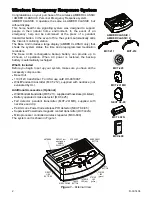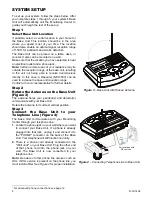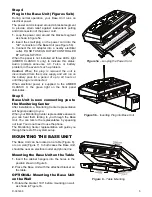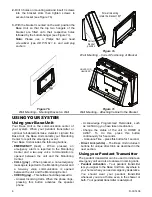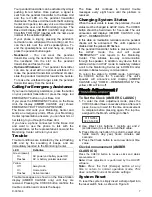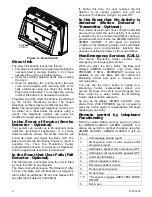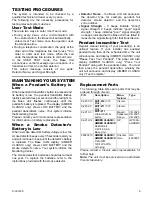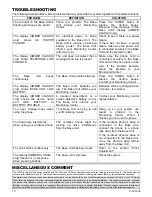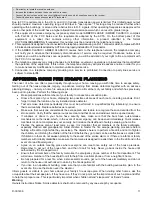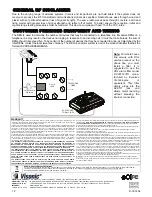
D-301436
11
– Re-orient or re-locate the receiving antenna.
– Increase the distance between the device and the receiver.
– Connect the device to an outlet on a circuit different from the one which supplies power to the receiver.
– Consult the dealer or an experienced radio/TV technician.
Due to FCC requirements in the U.S.A. and IC in Canada, transmission power is limited. This limited power output
should provide a maximum operating range of 400 feet in "open space". This range may be reduced further when
operating within buildings, or around other obstructions to R.F. signals. Other operating frequencies as approved for
use in other parts of the world have a higher allowed transmission power which can result in greater range.
1. This equipment, wireless emergency response system, model AMBER CLASSIC / AMBER CLASSIC X, complies
with Part 68 of the FCC Rules and the requirements adopted by the ACTA. On the bottom panel of this
equipment is a label, that contains among other information, a product identifier in the format
US:VSOAL00BAMBERNA. If requested, this number must be provided to the telephone company.
2. This equipment is designed to be connected to the telephone network using an RJ-11 connector which complies with Part
68 rules and requirements adopted by ACTA and a properly installed RJ-31X connector.
3. If the AMBER CLASSIC / AMBER CLASSIC X causes harm to the telephone network, the telephone company
will notify you in advance that temporary discontinuance of service may be required. If advance notice is not
practical, you will be notified as soon as possible. Also, you will be advised of your right to file a complaint with
the FCC if it is necessary.
4. The telephone company may make changes in its facilities, equipment, operations or procedures that could affect
the operation of the equipment. If this occurs, the telephone company will provide advance notice in order for you
to make necessary modifications to maintain uninterrupted service.
5. Connection to a telephone company providing coin service is prohibited. Connection to party lines service is
subject to state tariffs.
APPENDIX: HOME FIRE ESCAPE PLANNING
The onset of a fire can often spread rapidly throughout your home, leaving you with little time to escape safely.
Getting out of the house depends, largely, on advance warning from smoke detectors together with an advance
planning strategy – namely, a home fire escape plan familiar to all members of your family and which has previously
been put into practice. Perform the following steps:
•
Make preparations with members of your family to conduct an evacuation plan.
•
Draw a floor plan of your home, displaying two possible exit areas of each room, including windows. Don’t
forget to mark the location of every installed smoke detector.
•
Test all smoke detectors periodically (this must be performed in a qualified testing laboratory), to ensure
their serviceability. Replace batteries as required.
•
Make sure that everyone understands the escape plan and is able to recognize the sound emitted from the
smoke alarm. Verify that the escape routes are clear and that doors and windows can be opened easily.
•
If windows or doors in your home have security bars, make sure that the bars have quick-release
mechanisms on the inside, which, in the event of an emergency, can be opened immediately. Quick release
mechanisms do not compromise your security, but increase the likelihood of safely escaping a home fire.
•
Practice the escape plan at least twice a year. It is important that all members of the family participate,
especially children and grandparents. Allow children to master the fire escape planning procedure before
holding a fire drill at night while they are asleep. The objective here is to perform a fire drill, and not to frighten
the children, so informing the children of the fire drill before they go to bed can be as effective as a surprise drill.
If children or others do not awaken promptly to the sound of the smoke alarm, or if there are infants or family
members with mobility disabilities, make sure that someone is assigned to assist them in the fire drill and in the
event of a real-life emergency.
•
Agree on an outside meeting place where everyone can meet once safely out of the house premises.
Remember to get out of the house first, and then to call for help. Never go back inside the house until
authorized by the fire department.
•
Ensure that all members of the family memorize the emergency phone number of the fire department. This
will allow a member of the household to call for help from a cellular phone or from a neighbor’s home.
•
Be fully prepared for a real fire: when a smoke alarm sounds, get out of the house immediately and do not
return to the house until authorized to do so by the fire department!
•
If you live in an apartment building, make sure that you are familiar with the building evacuation plan. In the
event of a fire, use the stairs, never the elevator.
Inform guests or visitors to your home about your family’s fire escape plan. When visiting other homes, ask the
occupants about their escape plan, if they have one. If they do not, point out the importance of such a plan and offer
to help them prepare one. This is particularly important when children attend “sleepovers” at friends' homes.
Warning
Owners Instructions Notice: Smoke detectors shall not be removed by anyone except by occupants.


